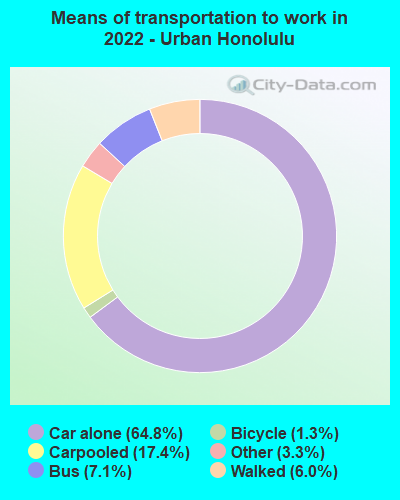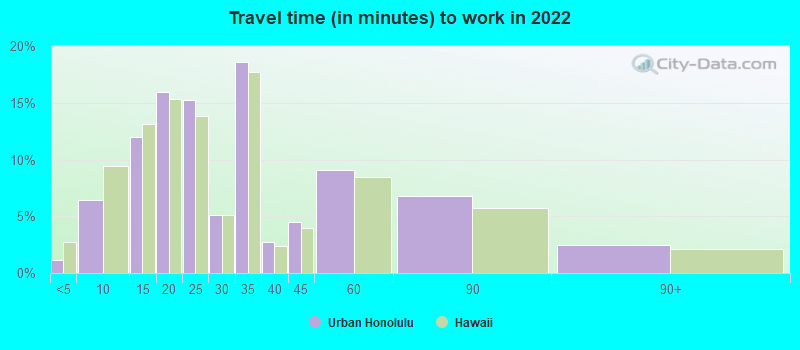Urban Honolulu, HI vs Ewa, HI
Urban Honolulu and Ewa are both popular cities in Hawaii, each with their own unique charm and appeal. Urban Honolulu, the capital, is known for its vibrant city life, bustling economy, diverse culture, and enticing tourist attractions, while Ewa is a suburban town treasured for its peaceful ambiance, serene beaches, lower cost of living, and family-friendly neighborhoods. This comparison aims to provide you a comprehensive glimpse into the lifestyle, costs, and facilities in both cities, if you're considering relocation or just planning a visit.

 Urban Honolulu, HI and
Urban Honolulu, HI and  Ewa, HI : 10.8 miles
Ewa, HI : 10.8 miles
Urban Honolulu's population is larger by 24%.
| Population | ||
| Type | Urban Honolulu | Ewa |
|---|---|---|
| Population | 345,510 | 279,683 |
| Female / male percentage | 50.1% / 49.9%
|
49.1% / 50.9%
|
Crime and Safety
Urban Honolulu encounters moderate crime rates compared to larger US cities. It possesses a complexity that comes with being the largest city and the capital of Hawaii, thus more policing. In contrast, Ewa has one of the lower crime rates within Hawaii, making it a safer option for families and retirees. Community involvement and neighborhood watch programs are common here. Both cities witnessed improvements in safety measures over past years, but Ewa provides a quieter, somewhat secure environment compared to the bustling Urban Honolulu.
Cost of Living
Urban Honolulu has a higher cost of living compared to Ewa, given its economic demand, higher housing costs, and overall city maintenance expenses. While Ewa's cost of living is also above the national average, it significantly undercuts Urban Honolulu, offering cheaper housing alternatives, hence, being more affordable for families and individuals on a tight budget. The grocery expenses in both cities are somewhat comparable.
Income Tax
Hawaii's income tax is levied on a progressive scale from 1.4% to 11%, one of the highest income taxes in the US. As both Ewa and Urban Honolulu fall under this jurisdiction, they have the same income tax requirements.
Property Tax
Honolulu County has the lowest property tax rate in the nation, averaged at about 0.270%. This is beneficial for homeowners in both Ewa and Urban Honolulu, with Ewa being slightly more affordable due to lower property values.
Sales Tax
Both cities fall under the same state taxation system. Hawaii doesn't have a sales tax but a general excise tax, which is 4.712% in Honolulu County, covering both Ewa and Urban Honolulu. This tax applies to all goods and services.
| Income | ||
| Type | Urban Honolulu | Ewa |
|---|---|---|
| Estimated median household income | $90,704 | $108,384 |
| Estimated per capita income | $39,573 | $37,904 |
| Cost of living index (U.S. average is 100) | 128.3 | 145.5 |
If you make $50,000 in Urban Honolulu, you will have to make $56,703 in Ewa to maintain the same standard of living.
Geographical Conditions
Urban Honolulu is on the southeastern coast of Oahu, blessed with beautiful beaches, hiking trails, and stunning landmarks like Diamond Head. Ewa is on the leeward side of Oahu with a laid-back beach town vibe, offering stunning coastal views and recreational outdoor activities.
Education
Honolulu boasts numerous high-ranking public and private schools, along with universities including the University of Hawaii at Manoa. Ewa also offers quality education with well-respected public schools. However, Honolulu is often preferred by families due to a wider range of educational opportunities for their children, including extracurricular programs. For higher education, commuting to Honolulu from Ewa is also a feasible option.
| Education level (25-year-olds and older) | ||
| Type | Urban Honolulu | Ewa |
|---|---|---|
| Bachelor's degree or higher | 39.9% | 25.1% |
| Graduate or professional degree | 15.2% | 6.6% |
| High school or higher | 91.6% | 85.9% |
Work and Economy
Urban Honolulu holds an economic advantage, being Hawaii's capital. The city has a diversified economy involving tourism, military defense, research and development, and manufacturing. Ewa's economy is more centered on local businesses, with many residents commuting to Honolulu for work. While job opportunities are more abundant in Honolulu, Ewa's slower pace can be appealing to some.
Biggest Employers
The State of Hawaii, the U.S. Federal Government, University of Hawaii, and Hawaii Pacific Health are some of the biggest employers in Honolulu. The Honolulu tourism sector also contributes significantly to employment. In Ewa, Campbell High School, Foodland Super Market, and City Mill Company Ltd are notable employers along with local businesses and retail stores.
Weather
Hawaii’s tropical climate blesses both Urban Honolulu and Ewa with pleasant weather throughout the year. The average temperature ranges from the mid 70s to mid 80s. However, Urban Honolulu tends to have more humidity due to its dense urban area, while Ewa enjoys slightly cooler and breezier conditions because of being closer to the coastline. Both cities are prone to tropical storms, but their infrastructure is equipped to handle these situations.
| Weather and climate | ||
| Type | Urban Honolulu | Ewa |
|---|---|---|
| Temperature - Average | 74.7°F | 74.8°F |
| Humidity - Average morning or afternoon humidity | 70.5% | 70.5% |
| Humidity - Differences between morning and afternoon humidity | 27% | 27% |
| Humidity - Maximum monthly morning or afternoon humidity | 79% | 79% |
| Humidity - Minimum monthly morning or afternoon humidity | 52% | 52% |
| Precipitation - Yearly average | 58.7 in | 22.8 in |
| Snowfall - Yearly average | 0 in | 0 in |
| Clouds - Number of days clear of clouds | 14.9% | 14.9% |
| Sunshine amount - Average | 71% | 71% |
| Sunshine amount - Differences during a year | 19% | 19% |
| Sunshine amount - Maximum monthly | 75% | 75% |
| Sunshine amount - Minimum monthly | 56% | 56% |
| Wind speed - Average | 11.1 mph | 11.1 mph |
Average climate in Ewa, Hawaii







| Natural disasters | ||
| Type | Urban Honolulu | Ewa |
|---|---|---|
| Tornado activity compared to U.S. average | 3.7% | 3.7% |
| Earthquake activity compared to U.S. average | 1,250.1% | 1,188.8% |
| Natural disasters compared to U.S. average | 16% | 16% |
Transportation
Urban Honolulu has extensive public transportation with TheBus system and is bicycle-friendly. It's also home to the main airport. Ewa has commuter options to Honolulu via public transportation or personal vehicles, with average commuting time being 30-45 minutes. Both cities lack extensive rail systems, but there's a planned transit rail project in Honolulu.
Real Estate
Housing costs are relatively high in Urban Honolulu, with a mix of high-rise condos, historic homes, and luxury properties. The real estate market in Ewa is significantly more affordable, offering single-family homes and townhouses, making it ideal for families or first-time homebuyers. Rental market is active in both cities, with Honolulu fetching higher rents due to its urban appeal.
Neighborhoods
Urban Honolulu offers vibrant neighborhoods like Downtown, Kakaako, and Waikiki, each with its own unique charm and city buzz. Ewa is more residential, with quiet, family-friendly neighborhoods like Ewa Beach, Ewa Gentry, Ocean Pointe, offering an escape from city life.
| Houses and residents | ||
| Type | Urban Honolulu | Ewa |
|---|---|---|
| Houses | 157,427 | 84,927 |
| Average household size (people) | 2.5 | 3.3 |
| Houses occupied | 138,398 (87.9%) | 80,101 (94.3%) |
| Houses occupied by owners | 68,458 (49.5%) | 53,297 (66.5%) |
| Houses occupied by renters | 69,940 (50.5%) | 26,804 (33.5%) |
| Median rent asked for vacant for-rent units | $1,712 | $1,835 |
| Median price asked for vacant for-sale houses and condos | $238,020 | $674,769 |
| Estimated median house or condo value | $781,600 | $698,772 |
| Renting percentage | 56.2% | 32.5% |
| Household income disparities | 45% | 35.6% |
| Housing units without a mortgage | 1,696 (4.1%) | 6,869 (16.9%) |
| Housing units with both a second mortgage and home equity loan | 6,219 (15.1%) | 419 (1%) |
| Housing units with a mortgage | 39,383 (95.9%) | 33,885 (83.1%) |
| Housing units with a home equity loan | 319 (0.8%) | 4,958 (12.2%) |
| Housing units with a second mortgage | 7,901 (19.2%) | 3,874 (9.5%) |
| Housing units lacking complete kitchen facilities | 2.6% | 0.6% |
| Housing units lacking complete plumbing facilities | 0.8% | 0.4% |
Industries and Occupations
In Honolulu, the major industries are tourism, healthcare, and construction. Also, the defense sector plays a significant role owing to the multiple military bases. In Ewa, retail, healthcare, and education are the driving industries, along with tourism on a smaller scale. While jobs in Ewa mostly revolve around these industries, many residents find employment in Honolulu and commute daily.
Health Care
Urban Honolulu features several of the state's largest hospitals, providing advanced healthcare facilities. Ewa community has healthcare facilities too, but they are smaller, and locals often visit Honolulu for specialized care. Availability of healthcare professionals is significantly higher in Honolulu.
Infrastructure
Urban Honolulu is well-developed with modern infrastructure including highways, shopping centers, downtown high-rises, historic landmarks, and plenty of tourist attractions. Ewa, on the other hand, has a suburban infrastructure with a mix of new and old residential areas. Rapid development has brought in many modern amenities into Ewa, making it a transition area between urban and rural.
| Infrastructure | ||
| Type | Urban Honolulu | Ewa |
|---|---|---|
| TV stations | 15 | 18 |
Culture and Food
Urban Honolulu offers a rich and diverse culture, reflected in its food, music, art, and festivals. A food lover’s paradise, it's known for a variety of cuisines from authentic Hawaiian to Asian fusion. Ewa also has a strong cultural presence, with local food outlets serving traditional Hawaiian cuisine and seafood. Honolulu has more dining options, but Ewa offers a more community-focused cultural experience.
Sports Teams
Hawaii doesn't have any major league sports teams, but it hosts events like the Honolulu Marathon, NFL Pro Bowl, and more. The University of Hawaii at Honolulu offers college-level sports. Ewa doesn't have professional sports teams or large-scale events, but neighborhood leagues and high school sports are quite popular.





